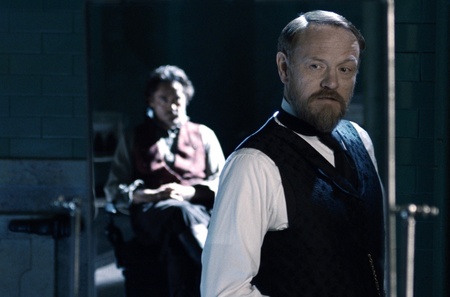Even though it competed against Avatar during its theatrical run, 2009's Sherlock Holmes grossed in excess of $500 million at the worldwide box office, making a sequel a high priority for Warner Brothers. Arriving two years after its predecessor, 2011's Sherlock Holmes: A Game of Shadows is a well-realised follow-up that does an admirable job of ironing out the original film's creases while both retaining and building upon its strengths. It's perhaps not quite as good as it could have been, but A Game of Shadows remains meticulously crafted and fiendishly clever.

As Dr. Watson (Law) prepares to marry his fiancée Mary (Reilly), Sherlock Holmes (Downey Jr.) is hot on the trail of his greatest adversary: Oxford professor James Moriarty (Harris). A series of anarchist bombings are taking place around London, and Holmes suspects that Moriarty is involved. Following his nuptials, Watson finds himself a target in Moriarty's evil machinations, and reluctantly teams up with Holmes once again to investigate the evil mastermind. As they work their way around Europe, Holmes and Watson happen upon mysterious gypsy fortune teller Sim (Rapace), whose brother has been kidnapped by Moriarty. Holmes' older brother Mycroft (Fry) also lends his expertise to the case as they grow closer to unravelling Moriarty's wicked plot of assassinations, bombings and the potential beginning of a world war.
Sherlock Holmes: A Game of Shadows may shock viewers who haven't yet acquainted themselves with Guy Ritchie's reinvention of the gentleman detective. Ritchie has spectacularly re-invigorated the ancient hero, retaining the character's unparalleled cerebral talents while adding 21st Century action-adventure sensibilities. Rather than a reserved pipe-smoker, this Sherlock Holmes is both physically and mentally lethal; he uses his gifts of analysis to engage in fighting and death-defying acts, and Ritchie employs engaging filmmaking techniques to highlight Holmes' bustling mind. It was a creative choice that worked in 2009's Sherlock Holmes, and it makes a welcome return here. Ritchie, of course, also retained his proclivity for stylish camera movements and kinetic energy, stuffing A Game of Shadows with a large number of thrilling action set-pieces and infusing the film with drive and momentum. Furthermore, the action set-pieces do not seem dumb or forced; they flow organically out of the structure of the narrative, and Holmes is such a crafty bastard that they never seem stupid. However, a few of the fights were shot too close, too fast and too dark, and Ritchie went overboard with his use of slow motion (the forest chase in particular is borderline disgusting in its overuse of slo-mo and "bullet time").

While it has lots of action, A Game of Shadows also relies on the complex relationship that Holmes and Dr. Watson share. There's time for their relationship to grow, and their bantering is often witty and amusing. Speaking of character interaction, the film is gripping when it pits Holmes against Moriarty. The exhilarating finale involves the two going head-to-head in an intense game of chess which tests both their mental and physical strength. It's the best sequence in the film; far more effective than any of the gunfights or brawls, and it's a shame that Ritchie and his writers didn't permit more time for the pair to engage in verbal combat.
Produced on a lavish budget, the picture looks expectedly fantastic. The somewhat rickety CGI of the 2009 original has been drastically improved, and the digital effects have been combined with lavish sets and costumes which exemplify careful attention to period detail. Hans Zimmer also returned to compose the score (his standout efforts on the first film earned an Oscar), and his flavoursome musical accompaniment is a huge asset.

Robert Downey Jr. is visibly more comfortable in the role of Sherlock Holmes here, and it's clear that he has found his groove. Downey's accent feels astonishingly lived-in, he oozes charisma, and he generally suits this vision of the character to the ground. Jude Law, meanwhile, is back here as Dr. Watson. Law's contributions should not be overlooked, as he's a sturdy and focused sidekick for Downey. Also terrific is Jared Harris, whose performance as Professor Moriarty is exceptional. Harris' biggest strength is the way that he can deliver menacing dialogue with chilling restraint while simultaneously convincing us that he's capable of committing heinous acts of crime. Another newcomer is Stephen Fry, whose performance as Mycroft is well-judged, charming and amusing. Noomi Rapace is not quite as good, but she's serviceable as the gypsy fortune teller who helps Holmes and Watson in their investigation. Rounding out the main players is Kelly Reilly and Rachel McAdams who briefly show up to reprise their roles of Mary Watson and Irene Adler (respectively).
While Sherlock Holmes: A Game of Shadows is an exciting, funny and intelligent action-adventure, it's not exactly the most soulful or substance-laden blockbuster you'll see. Ritchie's storytelling is admittedly still a bit garbled as well, though his abilities have markedly improved since the original movie. Even with its flaws considered, though, this is a strong sequel. With it having been infused with the same flavour as 2009's Sherlock Holmes, 2011's A Game of Shadows is a cosy companion piece for its predecessor. Further instalments are practically inevitable, and that's fine, because this new Sherlock Holmes franchise is shaping up to be something special.
7.5/10
 Login
Login
 Home
Home 183 Lists
183 Lists 1665 Reviews
1665 Reviews Collections
Collections
 0 comments,
0 comments, 































